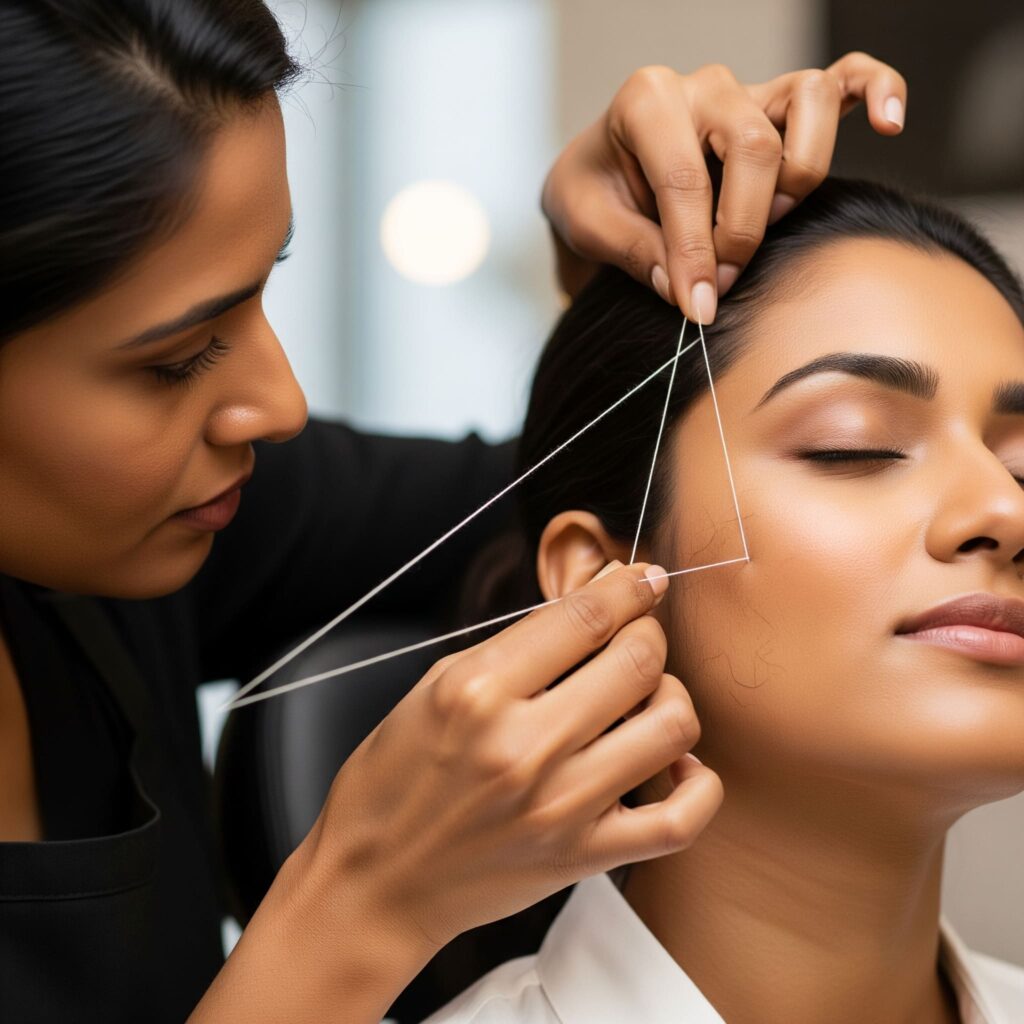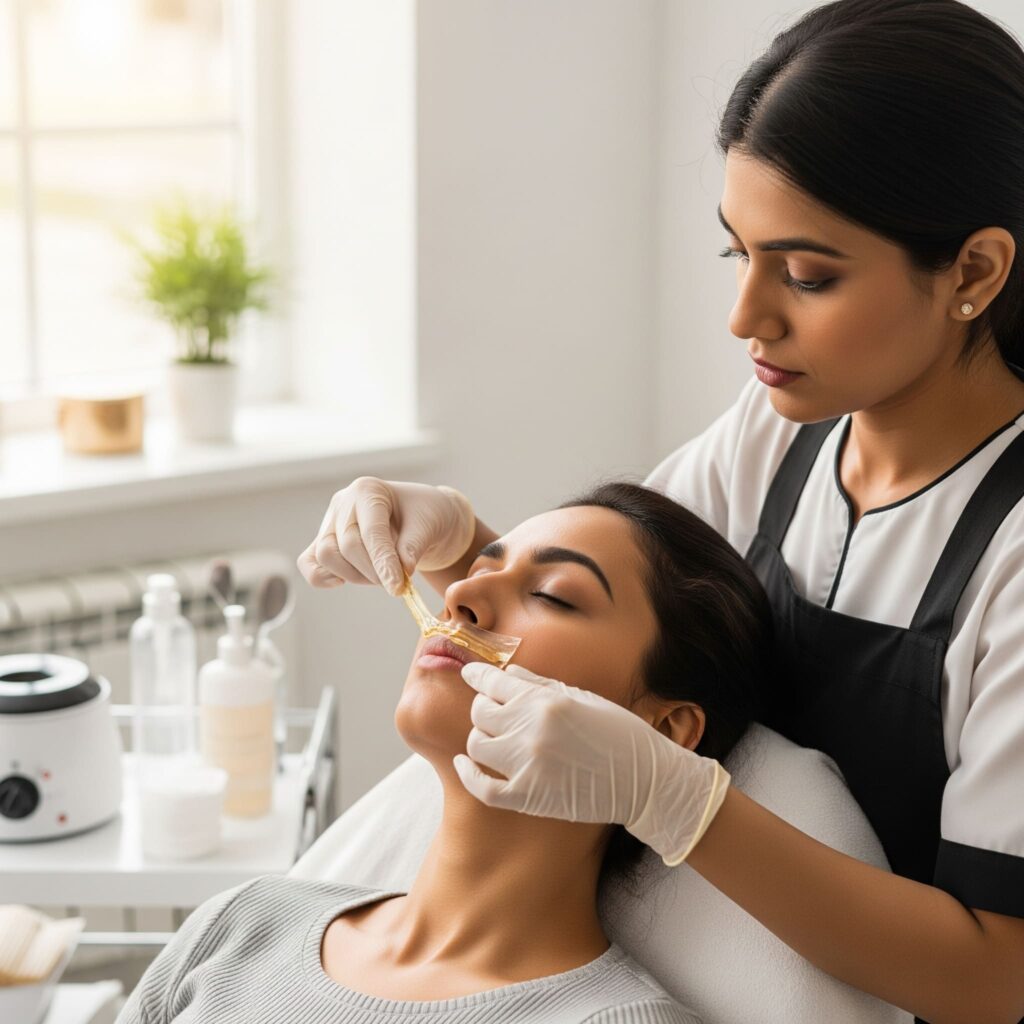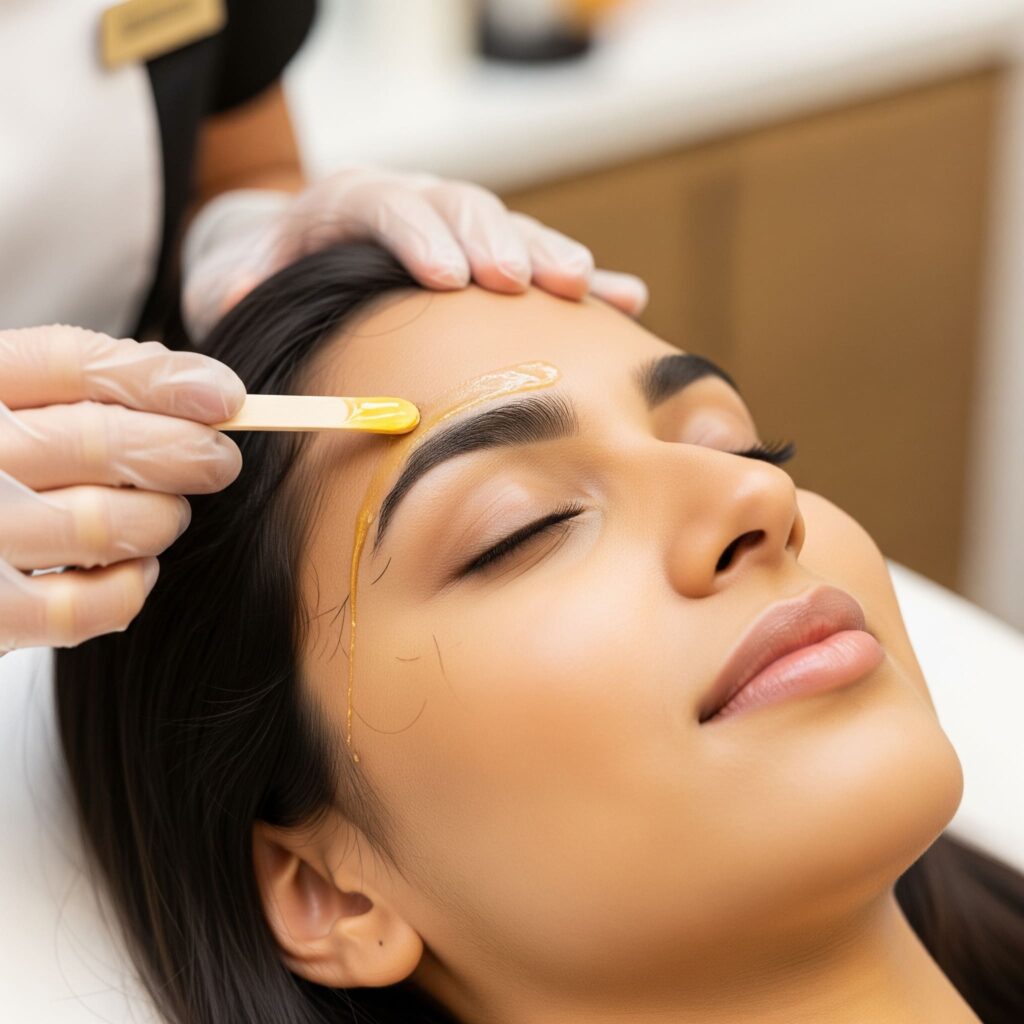Removing unwanted facial hair is a common skincare practice, yet the choice between threading vs waxing face remains a frequent dilemma. Both methods are popular, each offering distinct benefits and drawbacks. Whether you’re wondering if waxing or threading is better for the face, or curious about the threading vs waxing face comparison regarding which lasts longer, this article breaks down the essentials to help you make an informed decision.
Imagine preparing for an important event and ensuring your skin looks flawless without prickly hair shadowing your confidence. How do you decide which hair removal technique suits your skin type, pain tolerance, and desired results? Let’s explore the detailed differences, benefits, and side effects of threading vs waxing face facial hair removal.
Table of Contents
What is Face Threading?
Face threading is an ancient hair removal technique originating from South Asia and the Middle East. It uses a thin cotton thread twisted and rolled over unwanted facial hair, plucking the hair from the follicle root. Threading vs Waxing Face is a common comparison as both are popular methods for shaping eyebrows and removing hair from the upper lip, chin, and cheeks.

The technique requires precision and skill, typically performed by a trained esthetician. The thread traps hair and pulls it out in rows, leaving skin smooth immediately after. When deciding between threading vs waxing face treatments, threading is often preferred for its precision and suitability for sensitive skin, while waxing covers larger areas faster. Overall, understanding threading vs waxing face helps you choose the method that best suits your hair removal needs and skin type.
Advantages of Face Threading
Face threading offers precise hair removal with less irritation and longer-lasting results compared to waxing. The key benefit of threading vs waxing face is that threading is gentler on the skin, making it ideal for sensitive areas. Overall, threading vs waxing face provides a quicker and more comfortable experience with minimal risk of ingrown hairs or redness.
- Precision: Threading allows very precise hair removal, making it ideal for eyebrow shaping and delicate facial areas.
- No Chemicals or Heat: Since threading uses only cotton thread, it is chemical-free and thus suitable for sensitive skin types.
- Less Skin Contact: Threading avoids pulling or stretching the skin excessively, which can reduce irritation compared to waxing.
- Quick and Clean: The process is relatively quick and hygienic, requiring no sticky residues.
- Benefits for Facial Hair: Threading facial hair benefits include even hair removal from the root, making regrowth finer over time.
- No Risk of Burns or Allergies: Unlike waxing, threading poses no risk of burns or allergic reactions.
Disadvantages of Face Threading
Face threading has some disadvantages such as pain, redness, and the risk of infection. When considering Threading vs Waxing Face, threading may cause more discomfort and irritation for sensitive skin. In the Threading vs Waxing Face debate, waxing is often favored for longer-lasting results, but threading is quicker and more precise. Therefore, understanding the drawbacks is important when choosing between Threading vs Waxing Face treatments.
- Pain Sensation: Threading can cause discomfort or pain during hair removal, especially for first-timers or those with low pain threshold.
- Not Suitable for Large Areas: While effective on smaller facial zones, threading a full face threading vs waxing session can be time-consuming.
- Possible Redness: Immediately after threading, slight redness or bumps may appear on the skin.
- Skill-Dependent: The quality of the threading session greatly depends on the experience of the technician.
Step-by-Step Guide to Threading Your Face
For smooth and precise facial hair removal, understanding the difference between Threading vs Waxing Face is essential. Threading vs Waxing Face both remove hair from the root, but threading offers greater precision and is gentler on sensitive skin. When choosing between Threading vs Waxing Face, consider your skin type and the area you want treated for the best results. The steps for threading facial hair on the face are as follows:

Step 1: Clean the Area: Start with a clean, dry face. Remove any makeup, oils, or lotion from the skin to ensure smooth threading.
Step 2: Prepare the Thread: Cut a piece of 10-12 inches of 100% cotton thread. Tie the ends together to form a loop.
Step 3: Create the Twists: Hold the thread loop with your thumbs and forefingers on both hands, stretched into a rectangle shape. Twist one side about 8-10 times to create a twisted section in the middle.
Step 4: Position the Thread: Place the twisted section of the thread over the area with unwanted hair, resting gently on the skin.
Step 5: Threading Motion: Open one hand while closing the other, creating a scissor-like motion that moves the twisted part back and forth over the hair. This motion traps hairs and pulls them out from the roots. Always move in the opposite direction of hair growth for effective removal.
Step 6: Stretch the Skin: Use your free hand to gently stretch the skin taut near the area being threaded. This helps reduce discomfort and makes hair removal easier.
Step 7: Repeat as Needed: Continue the opening and closing motion, repositioning the thread to cover all unwanted hair in the area.
Step 8: Aftercare: Once finished, soothe the skin by applying a gentle moisturizer or oil. Some redness or mild irritation may occur but usually subsides quickly.
These steps can be done on small areas like the upper lip, eyebrows, or chin and require practice to master precision and comfort. Explore the top 9 bridal makeup types for your perfect wedding look-read now!
What is Face Waxing?
Face waxing involves applying a sticky wax (often warm) on the target skin area; then, a cloth or paper strip is pressed on top and pulled quickly in the opposite hair growth direction. This pulls out hair from the roots, leaving the skin smooth for several weeks. When comparing hair removal methods, Threading vs Waxing Face is a common topic, as both effectively remove facial hair but use different techniques.

Waxing can be done on the upper lip, chin, eyebrows, cheeks, and even the full face (depending on individual preference and skin sensitivity). In the debate of Threading vs Waxing Face, waxing covers larger areas more quickly and also exfoliates the skin, while threading offers more precision for sensitive or small areas. Understanding Threading vs Waxing Face helps you choose the best option for your skin type, hair texture, and desired results.
Advantages of Face Waxing
Face waxing offers many advantages, including longer-lasting smoothness and effective exfoliation compared to other methods. When deciding between threading vs waxing face, waxing provides a more precise hair removal from the root, resulting in finer regrowth over time. For those weighing threading vs waxing face, waxing is often preferred for covering larger areas quickly while leaving skin silky and radiant.
- Long-Lasting Results: Waxing removes hair from the roots, so regrowth is slower compared to shaving. This supports the question waxing vs threading which lasts longer, with waxing typically lasting longer-up to 3-6 weeks.
- Smooth and Exfoliated Skin: Waxing exfoliates dead skin cells along with hair removal, improving skin texture and brightness.
- Covers Larger Areas Quickly: Waxing can cover and remove hair from larger portions of the face faster than threading.
- Hair Regrowth Becomes Finer: Repeated waxing weakens hair follicles, resulting in finer and less dense regrowth.
- Precision in Shaping: Like threading, waxing allows shaping of eyebrows and delicate facial features with accuracy.
Disadvantages of Face Waxing
Disadvantages of face waxing include pain due to the sensitive skin of the face, redness, rashes, and occasional bumps or ingrown hairs. Threading vs waxing face is a common comparison because waxing can sometimes cause irritation or allergic reactions that threading may avoid. When deciding between threading vs waxing face, consider that waxing might lead to temporary redness and sensitivity, while threading is often gentler on the skin.
- Pain and Discomfort: Waxing is known for being painful, especially on sensitive facial skin, sometimes even more than threading.
- Waxing Side Effects on Face: Waxing can cause skin irritation, redness, ingrown hairs, burns if wax is overheated, and allergic reactions to ingredients in the wax.
- Not Ideal for Sensitive Skin: People with sensitive or acne-prone skin may experience flare-ups or inflammation after waxing.
- Requires Hair to Grow Out: For waxing to be effective, hair must be a certain length (usually ¼ inch), which means waiting between sessions.
- More Post-Care Needed: Aftercare like moisturizers and avoiding sun exposure is crucial to prevent irritation and pigmentation.
Step-by-Step Guide to Face Waxing
When deciding between threading vs waxing face, it’s important to understand the benefits of each method. Threading vs waxing face differ in technique, pain levels, and suitability for sensitive skin. Choosing the right method depends on your skin type and desired results in the threading vs waxing face comparison. Here are the detailed steps for face waxing, covering preparation, application, and aftercare:

Step 1: Prepare Your Skin
- Cleanse your face gently to remove all makeup, oils, and dirt. Use a gentle cleanser and pat dry.
- Exfoliate a day or two before waxing to remove dead skin cells and help the wax adhere better.
- Ensure your skin is completely dry before starting.
Step 2: Gather Your Tools and Wax
- Choose appropriate wax (hard wax is often preferred for sensitive facial skin).
- Use a wax warmer to heat the wax to a honey-like consistency.
- Have waxing strips (for soft wax), applicator sticks, and pre- and post-wax products ready.
Step 3: Section Your Face
- Divide the face into manageable zones (upper lip, chin, cheeks, forehead).
- Work on one section at a time for precision and easier control.
Step 4: Apply the Wax
- Using a spatula or applicator, apply a thin, even layer of wax in the direction of hair growth.
- If using soft wax, apply a strip firmly over the waxed area, leaving a “tab” for easy removal. Hard wax hardens on its own and does not need strips.
Step 5: Remove the Wax
- Hold the skin taut with one hand to reduce discomfort.
- Quickly pull the wax off in the opposite direction of hair growth with the other hand, pulling parallel and close to the skin to minimize pain and bruising.
- Repeat as necessary for missed spots, but avoid going over the same area twice immediately.
Step 6: Clean Up
- Remove leftover wax residue using a post-wax cloth or oil.
- Tweeze stray hairs if needed for a perfect finish.
Step 7: Post-Wax Care
- Apply a soothing serum or aloe vera gel to calm redness and irritation.
- Avoid sun exposure, heavy sweating, and harsh skincare products for at least 24 hours after waxing.
- Keep your skin moisturized and exfoliate gently a few days later to prevent ingrown hairs.
These steps help achieve smooth, hair-free facial skin while minimizing irritation and maximizing results. Discover various types of hair treatments to find your perfect hair care solution and get to know about the difference between keratin treatment vs hair straightening in the given blog.
Factors to Consider When Choosing Threading vs Waxing Face
When choosing between Threading vs Waxing Face, it’s important to consider your skin type and hair texture. Threading vs Waxing Face both remove hair from the root but differ in technique and lasting results. Ultimately, selecting the right method depends on your comfort, desired precision, and how long you want the smoothness to last.
| Factor | Threading | Waxing |
| Pain Level | Moderate pain, depends on skill | Higher pain, especially for sensitive skin |
| Duration of Results | 2 to 4 weeks | 3 to 6 weeks |
| Suitability for Sensitive Skin | Excellent, chemical-free | Can cause irritation, not ideal for sensitive skin |
| Speed and Coverage | Best for precise, small areas | Efficient for large areas like full face waxing |
| Hair Removal Precision | Very precise, great for fine details | Precise but less fine control than threading |
| Risk of Side Effects | Minimal, possible mild redness | Can cause redness, burns, allergic reactions, ingrown hairs |
| Aftercare Requirements | Minimal | Requires soothing lotions, sun protection |
Discover various types of hair treatments to find your perfect hair care solution and also Learn essential tips to keep your colored hair vibrant and healthy-read our expert blog now!
Which is Better Threading vs Waxing Face?
Choosing between threading vs waxing facial hair depends largely on your skin type, pain tolerance, and priority for lasting results.
- If you have sensitive skin, threading is generally better since it avoids chemicals, heat, and reduces irritation.
- For those wanting long-lasting smoothness with exfoliation benefits, waxing may be preferable.
- If precision shaping is your goal, threading offers more control.
- If you prefer quick removal on larger areas such as cheeks or full face, waxing can be more efficient.
- Consider waxing vs threading for sensitive skin carefully; waxing might aggravate delicate skin, causing side effects like redness or breakouts.
Ultimately, many people opt to combine both methods based on facial region and their specific skin needs. Consulting a professional esthetician can help you decide which suits you best. Explore our detailed blog to understand gel nails vs acrylic nails differences clearly!
Conclusion
When choosing between Threading vs Waxing Face, it’s important to consider your skin type and desired results. Threading offers precise removal and is gentler on sensitive skin, while waxing delivers longer-lasting smoothness with added exfoliation. Understanding the differences in Threading vs Waxing Face and proper aftercare helps you achieve the best outcomes. Ultimately, the right method in the Threading vs Waxing Face debate ensures you feel confident and comfortable in your skin.
For expert threading and waxing services tailored to your unique skin needs, visit Peacock Salon in Vashi, Navi Mumbai. Our experienced estheticians specialize in gentle, precise, and results-driven treatments that leave your skin smooth and refreshed. Find us at Mahavir Center, Shop No. 20, 21, 21A, 22, next to Golden Punjab Hotel, Sector 17, Vashi. Call +91 9324774567 to book your appointment and experience professional care that enhances your natural beauty.
Threading vs Waxing Face – FAQs
Is waxing or threading better for the face?
It depends on your skin type and pain tolerance. Threading is better for sensitive skin and precision, while waxing lasts longer and exfoliates skin.
Waxing vs threading which lasts longer?
Waxing generally lasts longer up to 3-6 weeks while threading lasts about 2-4 weeks because waxing removes hair from deeper roots.
What are the benefits of threading facial hair?
Threading offers precise hair removal with minimal irritation, is chemical-free, and creates finer regrowth over time.
What are the side effects of waxing on your face?
Possible side effects include redness, irritation, burns from hot wax, ingrown hairs, and allergic reactions to wax ingredients.
Can threading be done on full face?
Yes, but it can be time-consuming. Some prefer waxing for full face hair removal due to speed.
Is waxing or threading better for sensitive skin?
Threading is safer for sensitive skin because it uses no heat or chemicals, reducing irritation risks.
How painful is face threading compared to waxing?
Both can be painful, but many find waxing more uncomfortable due to the wax pulling on larger areas at once.
How often should I get my facial hair waxed or threaded?
Waxing is usually repeated every 3-6 weeks, threading every 2-4 weeks, depending on hair growth.
Does waxing or threading help hair grow back finer?
Both methods remove hair from the root; however, waxing often leads to finer, sparser regrowth over time.
What aftercare is needed post waxing or threading?
Avoid sun exposure, apply soothing moisturizers, avoid harsh chemicals, and keep skin clean to prevent irritation or infection.
